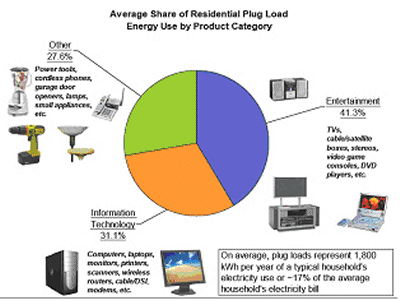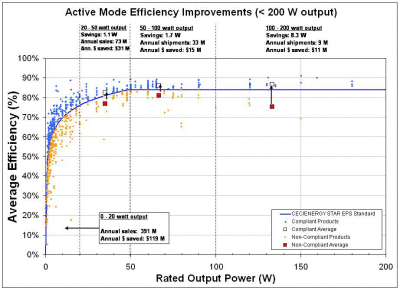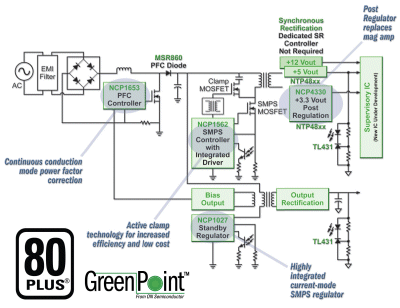About 3% of all electricity used in the U.S. is lost as heat in the process of power conversion
BY CHUCK MULLETT and DHAVAL DALAL
ON Semiconductor
Phoenix, AZ
http://www.onsemi.com
Concerns about energy consumption are growing throughout the world. Of the two ways to reduce the amount of energy we use, energy conservation requires conscious personal/societal decisions, while energy efficiency improvement is a pure technology play, transparent to the end user.
Around 3% of all electricity used in the U.S. is dissipated as heat in the process of power conversion. The power electronics industry, including semiconductor companies, power supply companies, and end-product manufacturers, is in the process of cutting these losses in half by increasing the conversion efficiencies and reducing standby power in high-volume consumer electronic products.
This article puts in perspective the energy losses in electronic products and reviews the techniques being employed to reduce them. Potential energy cost savings if these techniques are applied universally amount to $60 billion annually. If you are a power electronics industry professional, here is your chance to paint your collars green.
Some facts
Today, the amount of carbon emissions in the U.S. is 2.75 Gtons/year and this could increase 40% by the year 2050, if we continue on the current path. Electronics engineers (and especially power engineers) can play a significant role in this quest to save resources.
Some 6% to 10% of all U.S. electricity use is converted from ac to dc. By increasing the efficiency of the power supplies, 1% to 2% of all U.S. electricity consumption could be saved—a $3 billion to $6 billion per year potential savings.
The residential sector
U.S. residential electrical energy usage totals 1,300 billion kWh annually. Of this, 17% is due to “plug loads,” amounting to 221 billion kWh. This can be broken down into IT products at 31.1%, entertainment at 41.3%, and “other” at 27.6%. Figure 1 illustrates the breakdown.

Fig. 1. On average, plug loads represent 1,800 kWh per year of a typical U.S. household’s electricity use17% of the average household’s electricity bill.
In recent years, much has been done to raise the public interest in the conservation of electrical energy, with governments around the world initiating voluntary and mandatory programs to promote the design of more efficient products and more conscientious use of electrical energy. One of the most successful examples in the U.S. is Energy Star, a voluntary program that promotes more efficient products and encourages consumers to purchase them. The approach here is to survey existing products and then set a threshold that products must meet to earn the Energy Star label, as shown in Fig. 2 for active-mode efficiency improvements in external power supplies that produce less than 200-W output. Guidelines for no-load power consumption are also included.

Fig. 2. Products must meet an efficiency threshold to earn the Energy Star label for external power supplies.
The 80 PLUS program
As stated on www.80plus.org, “The 80 PLUS program is a unique forum that unites electric utilities, the computer industry and consumers in a groundbreaking effort to bring energy efficient power supplies to desktop computers and servers.” The specification requires 80% or better power supply efficiency at 20%, 50%, and 80% of full load, and a power factor of 0.9 or better. Over 450 desktop computer power supplies have qualified for the 80 PLUS label, and similar specifications are appearing all over the world.
Power factor correction
In addition to no-load and active-mode performance, a third requirementhigh power factoris often important, as stated in the 80 PLUS specification. In most countries, low input current harmonics are required in products with mains-connected input power of 75 W or greater. In switched-mode power supplies, this requirement is usually met by adding a power-factor correcting boost preregulator that shapes the input current to match the input voltage. This cuts input harmonics and thus reduces the rms value of the input current, saving the utility companies costs of producing reactive power and reduces expansion of infrastructure to provide higher current to the grid.
The challenge to power electronics designers
Stepping up to the challenge of keeping up with these evolving requirements, the Power Sources Manufacturers Association (PSMA, www.psma.com), has developed an interactive, energy regulation data base that allows one to navigate quickly to the regulations by region, application, country/state, or agency. Now, with the requirements easily obtained, the designer is ready to go to work on saving our planet!
Designing for power efficiency
As one might imagine, the new power supplies are highly dependent on the semiconductors— diodes, switching transistors, and control ICs. The semiconductor companies have rallied to the cause by providing compliant products. In order to facilitate the adoption of these new parts, they produce reference designs for specific applications, and these usually are accompanied by working pc-board versions of the designs with full documentation.
When the 80 PLUS program first appeared, ON Semiconductor produced one of their GreenPoint reference designs for the desktop computer power supply, and it was the first open design that met the 80 PLUS requirement. The design package is available at no charge to interested power supply manufacturers, and has been widely used to pursue these high-efficiency requirements. It is an example of an energy-efficient design that meets the stringent low-cost requirements of the high-volume consumer products market. The block diagram of this reference design is shown in Fig. 3 .

Fig. 3. ON Semiconductor’s 80 PLUS reference design is an example of an energy-efficient design that meets the stringent low-cost requirements of the high-volume consumer products market.
For more on power conversion, visit http://electronicproducts-com-develop.go-vip.net/power.asp.
Advertisement
Learn more about ON Semiconductor





